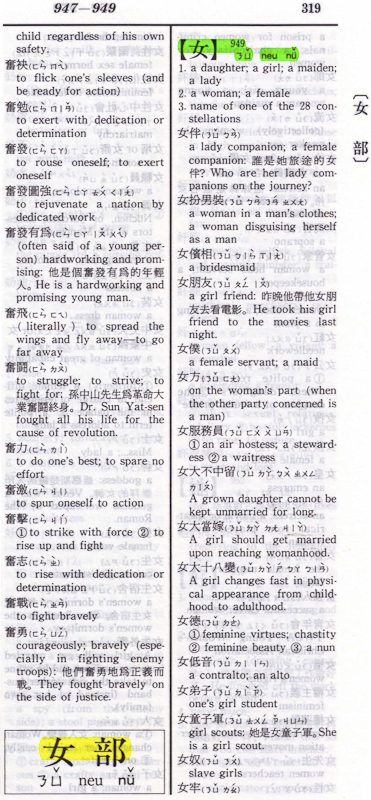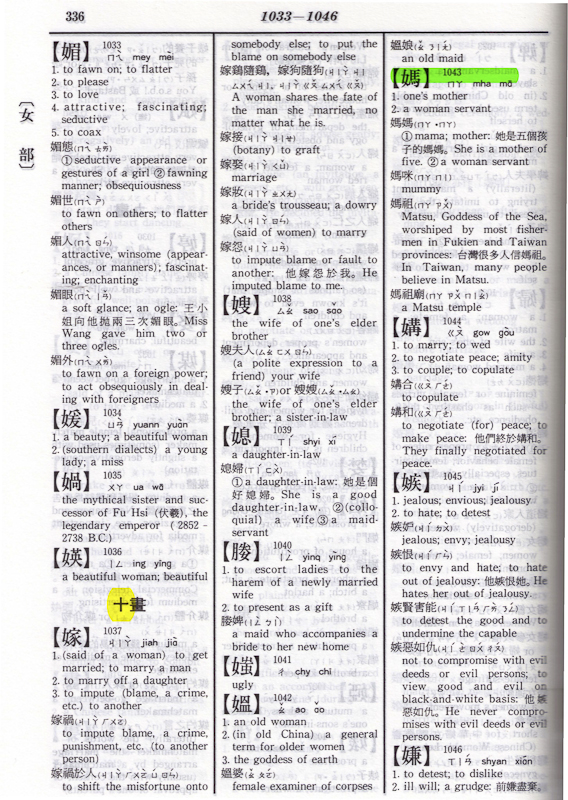At least as far as dictionaries are concerned. We can organize all the words alphabetically and it’s quite simple to look up the appropriate letter, narrow it down by the 2nd and 3rd letters and eventually arrive at the word you are looking for, complete with phonetic pronunciation guide, definition, etc. It’s not quite so easy in Chinese.
In order to use a Chinese dictionary, you have to be able to recognize the Chinese character, the radical used in the character, and the number of strokes needed to write the character. I’m learning now how to use my Chinese-English dictionary to look up characters I see, so I’m making a small tutorial here, complete with pictures, to help all of you as well.
First, we need a character to look up. This one will do nicely:
媽
We can see now that there are two parts to the character: a left half and a right half. Somehow, those two parts come together to form 1 character with 1 sound and meaning. Next, we need to identify which part of the character is the radical.
Chinese radicals are the semantic root of all characters. They are the part of the character that gives it its meaning. Most modern dictionaries agree that there are approximately 214 Chinese Radicals in the language, so you have to be able to recognize those 214 characters in order to further identify the remaining characters in the language. In this case, I’ll give you a hint: the radical for the character above is:
女
This character, when on it’s own, is pronounced nÇš and means “woman.” So, we know that the character above uses the woman radical and and has something to do with females. If you aren’t able to recognize radicals, you can still use a dictionary; it’ll just take a little longer. All dictionaries have lists of radicals where you look up the radical, get the page number, and then proceed to find your character. They look like this:

You can see that I’ve highlighted in green the section that contains radicals with 3 strokes. Additionally, I highlighted in yellow the radical we’re looking for. The dictionary says that radical, and all characters found under that radical, can be found on page 319, so let’s go there.

Again you can see in yellow this is where the section for the radical starts. In green, they begin listing all the meanings associated with just that radical and no extra strokes/characters attached to it. In order to look up our original character, 媽, we need to know how many strokes are needed to complete it. That is, we need to know how many strokes are needed to create the right half of the character. This time, I’ll help you out and tell you that the right half of the character requires 10 strokes to write. We shall proceed, therefore, to the page where they list all the characters using that radical plus 10 strokes.

There we are. In yellow I’ve highlighted that we are now at the “10 stroke” section. This will contain all the characters with 女 for a radical that require 10 additional strokes to finish. In green I’ve found our particular character. It’s complete with phonetic pronunciation (according to the Hanyu Pinyin as well as Zhuyin Fuhao (Mandarin phonetics/alphabet) and all the definitions and some handy phrases. In this case, our definition is the the first one, and the character we’re looking for is pronunced mÄ and means “mother.”
Interestingly, the right half of the character is also pronunced ma and can mean either “mother,” “horse,” “to scold” or it signals a question. This is all dependent on tone, of course, and whichever extra strokes accompany it.. So, the left half (the radical) gives the character its meaning and the right half gives the character its pronunciation. Both halves are working to form 1 character.
So next time you need to identify a character and have a dictionary handy, I trust you’ll be able to fend for yourself.
Leave a Reply